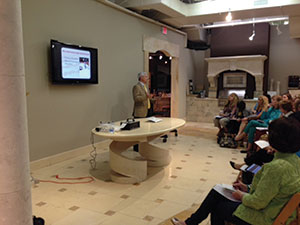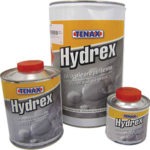November 2015
Natural Stone
By Jim Cook
Choosing the right stone for a project is more difficult than it sounds. Architects and designers must weigh a number of factors, including functionality, durability and availability, when selecting stone for construction projects. New training opportunities offered by the Marble Institute of America are aimed at helping designers and architects better understand natural stone and how to select the right material for the job.
 The Marble Institute of America (MIA) is launching a new continuing education program, “The Art of Specifying Natural Stone,” which will be presented as a free educational session at The International Surface Event West on Jan. 21, 2016. The program is a one-hour session that will teach architects and designers how to specify natural stone. The course will also be available through certified MIA CEU providers throughout the year.
The Marble Institute of America (MIA) is launching a new continuing education program, “The Art of Specifying Natural Stone,” which will be presented as a free educational session at The International Surface Event West on Jan. 21, 2016. The program is a one-hour session that will teach architects and designers how to specify natural stone. The course will also be available through certified MIA CEU providers throughout the year.
 “This course was developed because CEU (continuing education unit) program attendees have expressed a strong interest in a course about specifying natural stone,” says Sarah Gregg, CEU administrator for the MIA. “This new course will answer some of the most common questions about specifying and help participants better understand the topic.”
“This course was developed because CEU (continuing education unit) program attendees have expressed a strong interest in a course about specifying natural stone,” says Sarah Gregg, CEU administrator for the MIA. “This new course will answer some of the most common questions about specifying and help participants better understand the topic.”
Stone suitability will be a major focus of the seminar. Participants will learn about the three species of stone: sedimentary, igneous and metamorphic. They will also learn about stone types: calcareous or siliceous. Stone species and type have a huge impact on whether stone is suitable for certain uses.
Consider these facts about different stone types and their best uses in construction:
- Granites and basalts – These forms of stone work well for just about any indoor or outdoor application. Granites and basalts are igneous, siliceous forms of stone.
- Sandstone – A sedimentary, siliceous form of stone, sandstone works well for most indoor and outdoor applications. Laborers must pay careful attention when mechanically anchoring this variety of stone, however.
- Limestone and travertine – Both sedimentary and calcareous stone varieties, limestone and travertine work well for several outdoor and indoor applications. They may also work well for countertops, but do not always do well in kitchens.
- Marble – A metamorphic, calcareous form of stone, marble works quite well in interior applications and for some countertops, excluding food preparation areas. Outside use is more difficult and should be evaluated on a case-by-case basis.
- Slate, quartzite, serpentine, soapstone – These are metamorphic, siliceous stone varieties.
Product to WatchHydrex Stone Sealer |
 Tenax Hydrex Stone Sealer is a penetrating sealer that prevents liquids (stains) from penetrating into the material through its micro-porosities. Tenax Hydrex Stone Sealer is both waterproof and oil proof. Excellent for granite, carrara, Thassos, Trani, Botticini, marfill and similar stones. It is especially affective on polished granite and polished marbles. Tenax Hydrex Sealer allows the stone to breathe to maintain its natural characteristics. Tenax Hydrex Sealer may be used both indoors and outdoors. It does not change the color of the stone. Tenax Hydrex Sealer operates on the surface of materials. One liter of Hydrex will treat about 215 to 323 square feet of stone depending on the porosity of the stone. Test Hydrex on a small hidden area before using. Tenax Hydrex Stone Sealer is a penetrating sealer that prevents liquids (stains) from penetrating into the material through its micro-porosities. Tenax Hydrex Stone Sealer is both waterproof and oil proof. Excellent for granite, carrara, Thassos, Trani, Botticini, marfill and similar stones. It is especially affective on polished granite and polished marbles. Tenax Hydrex Sealer allows the stone to breathe to maintain its natural characteristics. Tenax Hydrex Sealer may be used both indoors and outdoors. It does not change the color of the stone. Tenax Hydrex Sealer operates on the surface of materials. One liter of Hydrex will treat about 215 to 323 square feet of stone depending on the porosity of the stone. Test Hydrex on a small hidden area before using.
For more information, visit info@tenaxusa.com. |
In general, they work well in a limited number of outdoor and indoor applications and are great for countertops.
Lecturers will address stone color, explaining how certain colors work better than others for particular applications. For example, darker color stone may be more suitable for floors as it is less likely to show dirt and stain easily.
“Architects and designers must have an understanding of the properties of stone, as well as its availability, durability and maintenance requirements,” Gregg says. “If they specify a stone that will not perform well in a particular setting that can lead to long term problems and shorten the lifespan of the project.”
Lecturers also will address the responsibility of each pillar in the typical construction project involving stone. Design professionals must select stone that will be the best fit for its application, from both an aesthetic and economic standpoint. Material suppliers must obtain stone that meets or exceeds the performance parameters of the intended application. Installing contractors are responsible for providing skilled labor to properly install the stone.
The end user of the facility needs to provide architects and designers with realistic requirements for the project and commit to proper maintenance once the project is complete. The session will also address some economic factors influencing stone selection. Attendees will learn to consider factors such as the proximity of quarries producing desired stone, the output of these quarries and their ease of access to transportation routes when making stone selections.
Lecturers will also address labor and logistics, explaining what stone types and finishes are more labor intensive than others and teaching attendees how to factor these considerations into their decisions. Gregg says demand by architects and designers led to the creation of the “The Art of Specifying Natural Stone” program.
 “CEU program participants fill out an evaluation form at the end of each course,” Gregg says. “When reviewing these forms, MIA noticed that many participants specifically said that they would benefit from a course focused on specifying natural stone. This shows there was a need for a course on the subject.”
“CEU program participants fill out an evaluation form at the end of each course,” Gregg says. “When reviewing these forms, MIA noticed that many participants specifically said that they would benefit from a course focused on specifying natural stone. This shows there was a need for a course on the subject.”
The MIA provides continuing education programs for architects, interior designers, kitchen and bath professionals and landscape architects that are recognized by dozens of professional organizations, including the American Institute of Architects, Interior Design Continuing Education Council, Landscape Architecture Continuing Education System, National Kitchen and Bath Association and more. The programs are valuable to firms, as it saves them from having to develop and implement their own continuing education programs. More than 2,000 architects and design professionals have participated in MIA continuing education courses this year.
To learn more, visit www.marble-institute.com/CEU. Jim Cook is a freelance writer based in Dothan, Ala. He can be reached atjim.cook.is@gmail.com.
In the NewsTwo PROSOCO Water Repellents Verified LBC-compliant |
| Two PROSOCO Sure Klean products, Siloxane PD and Natural Stone Treatment WB Plus, have been verified as compliant with the Living Building Challenge 2.0 and 3.0 Materials Petal Red Lists. This verification means that the water-repellent coatings do not contain intentionally added chemicals present on the Red List.
In addition, PROSOCO has certified that the products comply with all known architectural coating and sealant regulations, including the CARB 2007 SCM, SCAQMD Rule 1113 and SCAQMD Rule 314. For decades, PROSOCO cleaners and protective treatments have been used on high-value buildings such as state capitols, historic landmarks and emblematic structures recognizable around the world. “PROSOCO introduced modern, penetrating sealers to the U.S. market,” says Dwayne Fuhlhage, sustainability and environment director for PROSOCO. “Brick and natural stone masonry are intrinsically durable, but they are subject to the long-term ravages of moistures and time. We hope this latest Red List review helps to increase available tools for the Living Building Challenge community.” PROSOCO is a sponsor of the International Living Future Institute, which administers the Living Building Challenge as its flagship program for deep systemic change. For more information, visit www.prosoco.com. |

